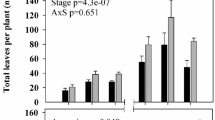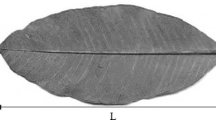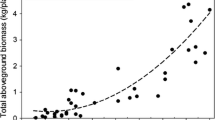Abstract
The coffee tree is an important economic plant for several developing countries. Stem and leaf dry biomass, which are key traits of plant production, are used in functional-structural plant models to simulate plant growth and predict yield. These values are difficult to obtain since they classically rely on time-consuming protocols and require destructive measurements. Measuring stem and leaf dimensions (length and width) to estimate them provides a non-destructive and rapid approach for use in the field. In this study we sought the best allometric relationships existing between stem and leaf dimensions and their corresponding dry mass in order to avoid destructive measurements which are also time-consuming. This was investigated in three coffee species: Coffea canephora, Coffea liberica var. liberica and Coffea liberica var. dewevrei in Ivory Coast. For each species, the internodes and leaves of three axis categories (stem, branch and branchlet) comprising the main compartments were sampled. Two different equations were found to estimate the stem and leaf dry mass whatever the species and the axis categories: (1) a linear equation for the relation between the stem volume (V) and its corresponding dry mass (IWe), IWe = 0.70 × V and (2) a power law for the relation between the leaf area [as the product of length (LL) and width (Wi)] and its dry mass (LWe), LWe = 0.007 (LL × LWi)1.02. Finally, stem and leaf dry mass could be easily obtained without destructive measurements. This method could be applied to estimate the plant total leaf area and the total stem and leaf biomass of a plant in an agroforestry system.





Similar content being viewed by others
References
Allen MT, Prusinkiewicz P, DeJong TM (2005) Using L-systems for modeling source-sink interactions, architecture and physiology of growing trees: the LPEACH model. New Phytol 166:869–880
Anthony F (1992) Les ressources génétiques des caféiers: collecte, gestion d’un conservatoire et évaluation de la diversité génétique. Collection Travaux et documents microfichés de l’IRD, n°81
Antunes WC, Pompelli MF, Carretero DM, DaMatta FM (2008) Allometric models for non-destructive leaf area estimation in coffee (Coffea arabica and Coffea canephora). Ann Appl Biol 153:33–40
Balandier P, Lacointe A, Le Roux X, Sinoquet H, Cruiziat P et al (2000) SIMWAL: a structural-functional model simulating single walnut tree growth in response to climate and pruning. Ann For Sci 57:571–585
Bell A (1991) Plant form: an illustrated guide to flowering plant morphology. Oxford University Press, London
Borianne P, Brunel G (2012) Automated valuation of leaves area for large-scale analysis needing data coupling or petioles deletion. In: Guo Y, Kang MZ, Dumont Y (eds) Plant growth modeling, simulation, visualization and applications. Proceedings PMA12: the fourth international symposium on plant growth modeling, simulation, visualization and applications, Shanghai, China, 31 October to 3 November 2012. IEEE Press, Beijing, pp 50–57
Bosc A (2000) EMILION, a tree functional-structural model: presentation and first application to the analysis of branch carbon balance. Ann For Sci 57:555–569
Cilas C, Bar-Hen A, Montagnon C, Godin C (2006) Definition of architectural ideotypes for good yield capacity in Coffea canephora. Ann Bot 97:405–411
DaMatta FM, Ronchi CP, Maestri M, Barros RS (2007) Ecophysiology of coffee growth and production. Braz J Plant Physiol 19(4):485–510
Davis AP, Govaerts R, Bridson DM, Stoffelen P (2006) An annotated taxonomic conspectus of the genus Coffea (Rubiaceae). Bot J Linn Soc 152:465–512
Davis AP, Tosh J, Ruch N, Fay M (2011) Growing coffee: Psilanthus (Rubiaceae) subsumed on the basis of molecular and morphological data; implications for the size, morphology, distribution and evolutionary history of Coffea. Bot J Linn Soc 167:357–377
de Reffye P, Hu B (2003) Relevant choices in botany and mathematics for building efficient dynamic plant growth models: the GreenLab case. In: Hu B, Jaeger M (eds) Plant growth models and applications. Tsinghua University Press, Springer, Beijing, pp 87–107
Diao J, De Reffye P, Lei X, Guo H, Letort V (2012) Simulation of the topological development of young eucalyptus using a stochastic model and sampling measurement strategy. Comput Electr Agric 80:105–114
Dias PC, Araujo WL, Moraes GABK, Barros RS, DaMatta FM (2007) Morphological and physiological responses of two coffee progenies to soil water availability. J Plant Physiol 164:1639–1647
Godin C, Caraglio Y (1998) A multiscale model of plant topologic structures. J Theo Biol 191:1–46
Griffon S, de Coligny F (2014) AMAPstudio: an editing and simulation software suite for plants architecture modelling. Ecol Model. doi:10.1016/j.ecolmodel.2013.10.037
Hallé F, Oldeman RAA, Tomlinson PB (1978) Tropical trees and forests. Springer, Berlin
Leroy T, Montagnon C, Cilas C, Yapo A, Charmetant P, Eskes AB (1997) Reciprocal recurrent selection applied to Coffea canephora Pierre. III. Genetic gains and results of first cycle intergroup crosses. Euphytica 95:347–354
Leroy C, Saint-André L, Auclair D (2007) Practical methods for non-destructive measurement of tree leaf area. Agrofor Syst 71:99–108. doi:10.1007/s10457-007-9077-2
Lopez G, Favreau RR, Ssmith C, Costes E, Prusinkiewicz P (2008) Integrating simulation of architectural development and source–sink behavior of peach trees by incorporating Markov chains and physiological organ function submodels into L-PEACH. Funct Plant Biol 35:761–771
Mathieu A, Cournède PH, Letort V, Barthelemy D, de Reffye P (2009) A dynamic model of plant growth with interactions between development and functional mechanisms to study plant structural plasticity related to trophic competition. Ann Bot 1–14. doi:10.1093/aob/mcp054
Montagnon C (2000). Optimisation des gains génétiques dans le schéma de sélection récurrente réciproque de Coffea canephora Pierre. PhD thesis, ENSA Montpellier, France
Niinemets Ü (2001) Global-scale climatic controls of leaf dry mass per area, density and thickness in trees and shrubs. Ecology 82:453–469
Perttunen J, Sievänen R, Nikinmaa E (1998) LIGNUM: a model combining the structure and the functioning of trees. Ecol Model 108:189–198
Rauscher HM, Isebrands JG, Host GE, Dickson RE, Dickmann DI (1990) ECOPHYS: an ecophysiological growth process model for juvenile poplar. Tree Physiol 7:255–281
Rosati A, Paoletti A, Caporali S, Enzo Perri E (2013) The role of tree architecture in super high density olive orchards. Sci Hort 161:24–29
Schmildt ED, do Amaral JAT, Santos JS, Schmildt O (2015) Allometric model for estimating leaf area varieties of Coffee. Rev Cie Agro 46(4):740–748
Siles P, Harmand JM, Vaast P (2010) Effects of Inga densiflora on the microclimate of coffee (Coffea Arabica L.) and overall biomass under optimal growing conditions in Costa Rica. Agroforest Syst 78:269–286
Tondjo K, Brancheriau L, Sabatier SA, Kokutse AD, Akossou A, Kokou K, Fourcaud T (2015) Non-destructive measurement of leaf area and dry biomass for estimating photosynthesis production in Tectona grandis. Trees. doi:10.1007/s00468-015-1227
Wang F, Letort V, Lu Q, Bai X, Guo Y, De Reffye P, Li B (2012) A functional and structural mongolian scots pine (Pinus sylvestris var. mongolica) model integrating architecture, biomass and effects of precipitation. PLOS One 7(8):1–13
Yan HP, Kang MZ, De Reffye P, Dingkuhm M (2004) A dynamic architectural plant model simulating resource-dependent growth. Ann Bot 93:591–602
Acknowledgments
This work was supported by the “Jeune Equipe Associée à l’Institut de Recherche pour le Développement (JEAI) Program”, project ModelCaf, by the plant Diversity Adaptation and Development, joint research unit (UMR DIADE) and by the Botany and Computational Plant Architecture, joint research unit (UMR AMAP). We thank the CNRA station at Divo for their technical support and facilities for the field trials.
Author information
Authors and Affiliations
Corresponding author
Rights and permissions
About this article
Cite this article
Okoma, P., Akaffou, S., De Reffye, P. et al. Estimation of stem and leaf dry biomass using a non-destructive method applied to African Coffea species. Agroforest Syst 92, 667–675 (2018). https://doi.org/10.1007/s10457-016-0031-z
Received:
Accepted:
Published:
Issue Date:
DOI: https://doi.org/10.1007/s10457-016-0031-z




